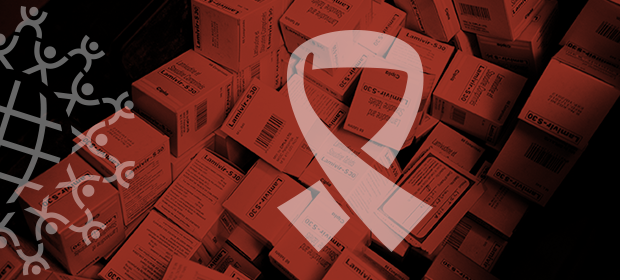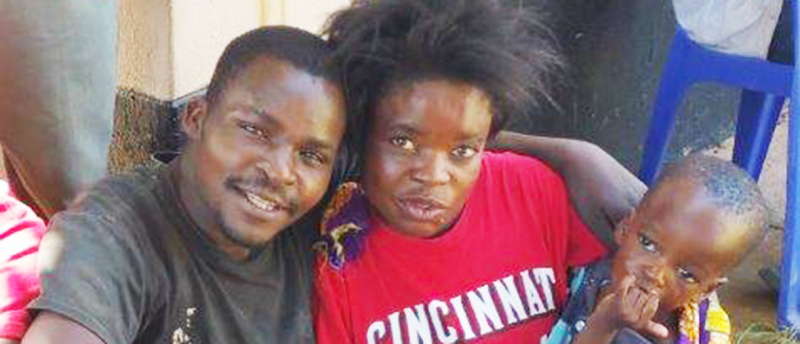Where We Work
See our interactive map


A simple document from a trained health worker can give clients the courage they need to face the virus head-on.
Hildah Maswabi waits for the health worker to write down her details—full name, address, telephone number, gender, HIV/TB statuses—on her referral form so she can take it to the nearest local health center.
The mood as she waits is somber. Finally, after the lay provider has written and reviewed everything for completeness and correctness, Hildah takes the form with a sigh of relief. It is only when I talk to her that I understand how much it represents to her.
I finally found the courage to come and be tested.
We are in Ngwerere in Chongwe District, a peri-urban area of Lusaka Province, Zambia. This is just one of the sites where IntraHealth International Zambia conducts mobile community HIV testing services.
Hildah’s story is similar to those of a lot of rural Zambians. She is 34, a mother of three children, divorced. She has never gone to school and is a casual worker, taking any job available to her, earning very little. She has lived with her parents since her divorce four years ago.
Hildah is usually a very strong woman, she tells me, but she noticed lately that her health hasn’t been so good. But she couldn’t afford to refuse work. It took her over three months to go to the nearest health post, where she had heard IntraHealth provides HIV testing services on Wednesdays.
“What made you decide to come today?” I asked Hildah.
“I wanted to know my status,” she said. “And here I am. I finally found the courage to come and be tested. Now I know what is going on with me. I am so happy that I finally have a referral and the doctors will help me now.”
Giving the HIV counselors in mobile clinics the power to refer clients to health facilities is one of IntraHealth’s successes in Zambia.
Clients see their referrals as the key to information they need to stay healthy, and as the culmination of all the weeks, months, or sometimes years of summoning the courage to visit the nearest health center.
The fears of stigma and discrimination that emerged with the HIV epidemic in Zambia in the 1980s persist here today. Visiting the hospital, or even the clinical center, is frightening. People find themselves lost in long corridors, some (like Hildah) unable to read, not knowing which sign to follow, and ashamed to ask someone where to go. Fear of stigma makes people like Hildah worry they will be treated poorly if they’re seeking HIV services.
IntraHealth has provided Hildah and many others with a safe environment and direct consultation with trained health workers. The guidance and referrals they receive give them the courage to take the next step, to seek further prevention, care, or antiretroviral therapy (ART) services.
Today with my routine checkups and ART provisions, I can kick anything.
A year later, Hildah is glad she took that first step to get tested.
“My fears were dictated by unawareness,” she says. “Once I came to know that HIV is nothing more than a disease and that it can be controlled by medication, I accepted my status wholeheartedly. Today with my routine checkups and ART provisions, I can kick anything. I feel strong. And that was the beginning of my dream to make my life and my children’s lives better. I believe in this dream. My children have been tested and were found negative.”
But not all children in this community were getting the testing services they need.
Waiting in the queue for HIV testing services that day I met Hildah was a worried-looking family. A woman named Bupe (33) who sells fruits on the side of the road, her husband Anderson Chilumbu (34), a small-time brick layer and a seasonal commercial farm laborer, and their baby boy, who was crying. Bupe had been waiting a long time for her husband to have time away from work so they could come to the health center together and have health workers see their baby.
Unfortunately, the lay providers could not test their son for HIV. The rapid testing kits they use for children aren’t always accurate for babies under two, and so they referred the family to the nearest facility for a dried blood spot test, the recommended testing method for babies under 18 months old.
Bupe and Anderson were not daunted. There was joy on their faces when they finally spoke with the lay provider—someone from their own community who was reassuring and understanding—and were given what they needed: a letter of referral to the health center, where they could get their baby the testing and care he needed. The provider urged them to go as soon as possible.
They did. And as it turned out, they tell us a year later, their son had had severe malaria, and was treated.
“Now, we have a beautiful child whose growth is progressing well,” Anderson says. “The referral letter improved our lives tremendously.”
To help more children get access to the HIV testing and services they need, IntraHealth Zambia has trained lay providers in the ten districts in which it works to provide this service for children 14 years of age and younger. This is one way Zambia is working toward the global targets to reduce new pediatric infections by 90% and population-level mother-to-child infection rates to under 5%. Through our weekly HIV testing sessions, we are working to bring Zambian communities closer to the services and reassurance they need to end HIV stigma and new infections. Jacqueline Kabeta contributed reporting to this piece.
IntraHealth’s work in Zambia is conducted with funding from the Centers for Disease Control and Prevention and PEPFAR under Improving and Expanding Access and Uptake of HIV Testing and Counseling for Individuals, Couples, and Families in selected Urban and Rural Populations in Lusaka, Western and Southern Provinces of the Republic of Zambia.

“My fears were dictated by unawareness,” Hildah Maswabi says. “Once I came to know that HIV is nothing more than a disease and that it can be controlled by medication, I accepted my status wholeheartedly." Photo by Nadia Lévêque.

From left, Anderson Chilumbu, Bupe, and their son. "Now we have a beautiful child whose growth is progressing well,” Anderson says. “The referral letter improved our lives tremendously.” Photo by Nadia Lévêque.
Get the latest updates from the blog and eNews




